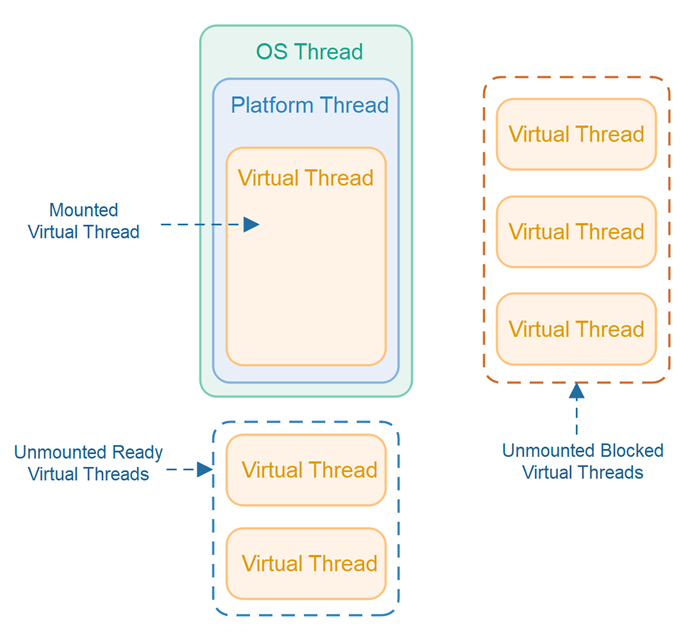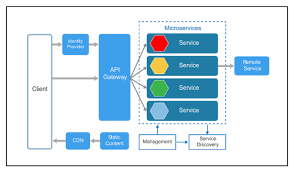 <
<15
DecemberVIRTUAL THREADS OVERVIEW
Description
VIRTUAL THREADS OVERVIEW
New type of thread that tries to overcome the resource limitation problem of platform thread. They are an alternate implementation of the java.lang.Thread type, which stores the stack frames in the heap ( garbage-collected memory) instead of the stack. Therefore, the initial memory footprint of a virtual thread tend to be very small, a few hundred byte instead of megabytes. At a high level, a thread is managed and scheduled by the operating system, while a virtual thread is managed and scheduled by a virtual machine. we'd like to scale our application by adding more threads, due to the context switching and their memory footprint, the cost of maintaining those threads may be significant and affect the processing time. virtual threads are managed by the JVM. Therefore, their allocation doesn't require a system call, and they're free of the operating system's context switch.since we're free of the system's context switch, we could spawn many more such virtual threads. New virtual threads are queued up until a platform thread is ready to execute it. When a platform thread becomes ready, it will take a virtual thread and start executing it. the platform thread does not switch between executing multiple virtual threads - except in the case of blocking network calls. virtual threads, a lightweight implementation of threads provided by the JDK instead of the OS. The number of virtual thread can be much larger than the number of OS threads. These virtual threads help increase the throughput of the concurrent applications. Thread.ofVirtual() and Thread.ofPlatform() are new APIs for creating virtual and platform threads Use Thread.startVirtualThread(Runnable) to quickly create and start a virtual thread.Java virtual threads are a new thread construct added to Java from Java 19. Java virtual threads are different from the original platform threads in that virtual threads are much more lightweight in terms of how many resources (RAM) they demand from the system to run. Thus, you can have far more virtual threads running in your applications than platform threads.
Why Use Virtual Threads?
Scalability: Since a large number of virtual threads are easy to create, the thread-per-request programming style alleviates this scalability bottleneck. In other words, high throughput is very simple to achieve.
Simplified Concurrency: Virtual threads make concurrent programming in Java easier by allowing developers to write code using familiar synchronous APIs. This eliminates the need for complex asynchronous programming patterns, such as callbacks, promises, or reactive programming, which can be difficult to understand and maintain.
Improved Resource Utilization: Virtual threads help maximize resource utilization by ensuring that kernel threads are not idle while waiting for I/O operations to complete. By efficiently managing the execution of virtual threads, the Java runtime can keep kernel threads busy, resulting in better overall performance. Virtual threads are not faster threads — they do not run code any faster than platform threads. They exist to provide scale (higher throughput), not speed (lower latency). creates a virtual thread and starts it immediately, executing the Runnable passed to the start() method. @SuppressWarnings("preview").Thread vThread = Thread.of Virtual().start(runnable); If you do not want the virtual thread to start immediately, you can use the unstarted()method instead. @SuppressWarnings("preview").Thread vThreadUnstarted = Thread.ofVirtual().unstarted(runnable); To start an unstarted virtual thread you just call the start() method on it, like this: vThreadUnstarted.start();
Why Use Virtual Threads?
Scalability: Since a large number of virtual threads are easy to create, the thread-per-request programming style alleviates this scalability bottleneck. In other words, high throughput is very simple to achieve.
Simplified Concurrency: Virtual threads make concurrent programming in Java easier by allowing developers to write code using familiar synchronous APIs. This eliminates the need for complex asynchronous programming patterns, such as callbacks, promises, or reactive programming, which can be difficult to understand and maintain.
Improved Resource Utilization: Virtual threads help maximize resource utilization by ensuring that kernel threads are not idle while waiting for I/O operations to complete. By efficiently managing the execution of virtual threads, the Java runtime can keep kernel threads busy, resulting in better overall performance. Virtual threads are not faster threads — they do not run code any faster than platform threads. They exist to provide scale (higher throughput), not speed (lower latency). creates a virtual thread and starts it immediately, executing the Runnable passed to the start() method. @SuppressWarnings("preview").
Thread vThread = Thread.of Virtual().start(runnable);
If you do not want the virtual thread to start immediately, you can use the unstarted()method instead. @SuppressWarnings("preview").
Thread vThread Unstarted = Thread.ofVirtual()
.unstarted(runnable); To start an unstarted virtual thread you just call the start() method on it, like this:
vThreadUnstarted.start();

